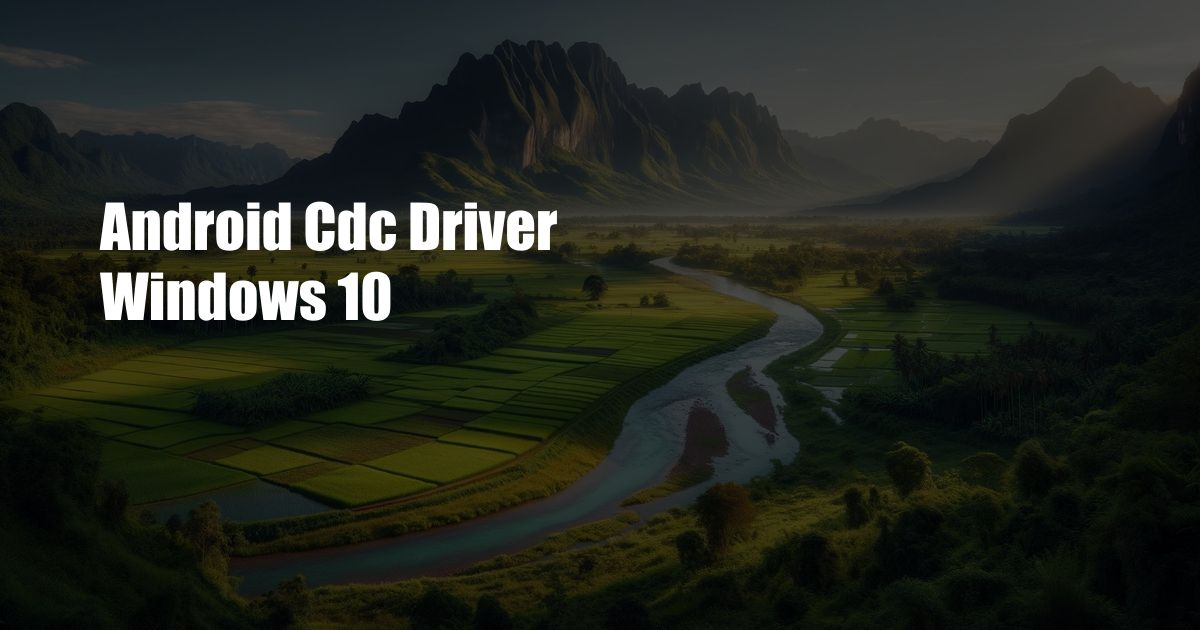
Android CDC Driver for Windows 10: A Comprehensive Guide
Imagine yourself, a tech enthusiast, eager to connect your Android smartphone to your Windows 10 PC for seamless data transfer and management. However, you hit a roadblock when your PC fails to recognize your device. The culprit? Missing or outdated Android Composite ADB Interface (CDC) drivers.
This article will serve as your ultimate guide to Android CDC drivers for Windows 10. We’ll cover everything you need to know, from their purpose and history to the latest trends and expert advice. By the end, you’ll have a thorough understanding of these drivers and how to optimize them for a smooth Android-PC connection.
What is the Android CDC Driver?
The Android CDC driver is a software component that enables communication between your Android device and your Windows 10 PC. It facilitates data transfer, debugging, and device management tasks. Without this driver, your computer won’t be able to recognize your Android smartphone or tablet.
The CDC driver is based on the USB communication protocol, which allows devices to communicate over a standard USB cable. When you connect your Android device to your PC, the CDC driver establishes a virtual serial port that allows your computer to communicate with your device as if it were a serial device.
How to Install the Android CDC Driver
Installing the Android CDC driver is a straightforward process. Follow these steps to get started:
- Connect your Android device to your PC using a USB cable.
- Open the Device Manager on your PC.
- Expand the “Portable Devices” or “Other Devices” category.
- Right-click on your Android device and select “Update Driver Software”.
- Select “Browse my computer for driver software”.
- Navigate to the folder where you downloaded the Android CDC driver.
- Click “OK” to install the driver.
Once the installation is complete, your Android device should be recognized by your PC. You can now transfer files, debug your device, and manage it using Windows tools like the ADB (Android Debug Bridge).
Tips for Optimizing Android CDC Driver Performance
Here are a few tips to help you optimize the performance of your Android CDC driver:
- Use the latest driver version: Always check for updates to your Android CDC driver. The latest version may contain bug fixes and performance improvements.
- Disable unnecessary drivers: If you have multiple Android devices connected to your PC, disable the drivers for the devices that you’re not using. This can help reduce conflicts and improve performance.
- Use a high-quality USB cable: A damaged or low-quality USB cable can cause connection problems. Use a high-quality USB cable that is designed for data transfer.
- Restart your computer: If you’re experiencing problems with your Android CDC driver, try restarting your computer. This can help clear out any temporary glitches that may be causing the problem.
FAQ on Android CDC Drivers
Here are some frequently asked questions about Android CDC drivers:
- Q: What is the difference between a CDC driver and an MTP driver?
A: A CDC driver is used for data transfer and debugging, while an MTP driver is used for media transfer. MTP drivers are typically included with Windows 10, so you don’t need to install them separately. - Q: Why am I getting a “Device not recognized” error when I connect my Android device?
A: This error can be caused by a missing or outdated CDC driver. Try updating your driver or installing the latest version. - Q: Can I use the Android CDC driver with other operating systems?
A: Yes, the Android CDC driver is also compatible with other operating systems, such as Linux and macOS.
Conclusion
The Android CDC driver is an essential piece of software that allows your Android device to communicate with your Windows 10 PC. By following the tips and advice in this article, you can optimize the performance of your CDC driver and ensure a smooth and reliable connection between your devices.
If you have any further questions about Android CDC drivers, feel free to leave a comment below or contact me directly. I’m always happy to help!

 Hogki.com Trusted Information and Education News Media
Hogki.com Trusted Information and Education News Media